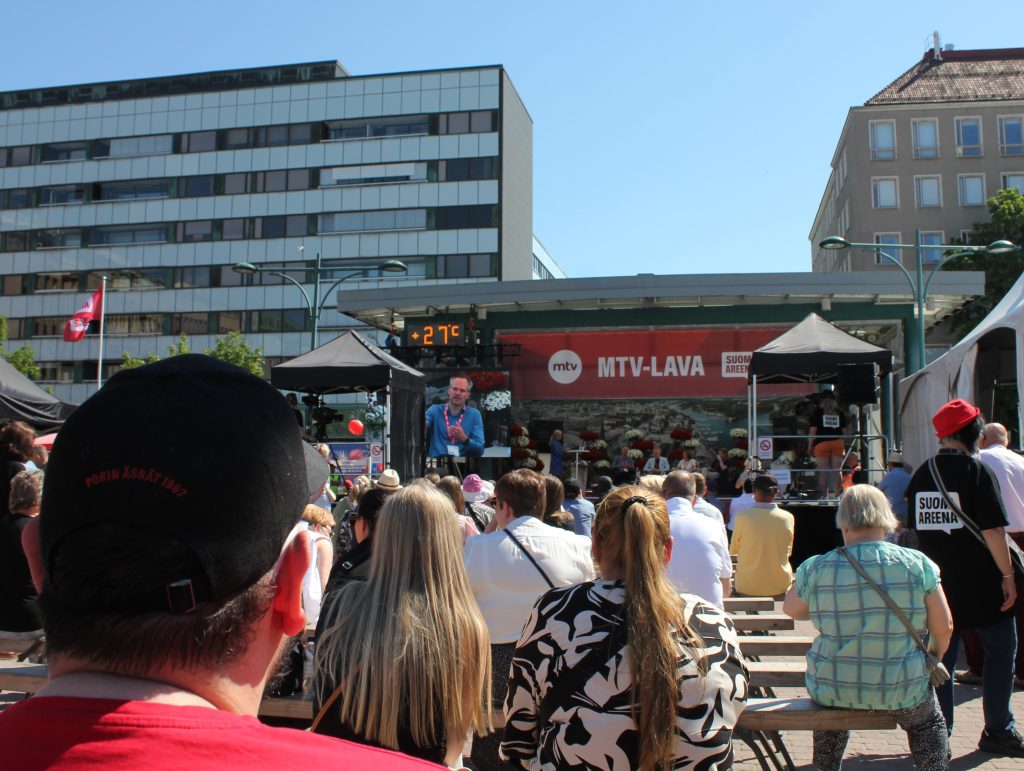Milla Syväoja, Sanna Lindgren
Kuvat: Milla Syväoja
SuomiAreena järjestettiin kesäkuun viimeisellä viikolla 25.-28.6.2024 ja tarjolla oli useita mielenkiintoisia keskusteluja myös rakennettuun ympäristöön liittyen. Torstaina torilla keskusteltiin kiertotaloudesta isossa mittakaavassa ja pohdittiin, miten Suomessa kierrätysastetta saataisiin kasvatettua. Jäte tulee olemaan tulevaisuuden raaka-aine ja tämä tulee ottaa huomioon lainsäädännössä. Keskustelijoiden mukaan meillä on teoria ja käsitteet hallussa, mutta nyt tarvitaan konkreettisia tekoja, joilla asiat saadaan menemään eteenpäin. Rakentamisessa vähähiilisyyden tavoitteet ohjaavat jo kiertotalouteen, mutta käytännön tasolla on löydettävä tapoja, joilla raaka-aineita pystytään kierrättämään paremmin. Kiertotaloudesta tulisi tehdä houkutteleva investointien näkökulmasta ja talouden tulisi tukea materiaalitaloutta, joka nojaa kiertotalouteen. Kiertotalousratkaisuja on vaikea tehdä yksin, joten yritysten on etsittävä erilaisia uusia kumppanuuksia. Ehkä tarvittaisiin myös kannustimia. Rakentamisessa kiertotaloutta ovat myös korjaukset ja käyttötarkoituksen muutokset. Meillä jälkimmäisen esteeksi saattaa usein tulla lainsäädäntö, kun taas esimerkiksi Canadassa Calgaryssa saa 500 €/m² kannustinrahaa muuttaessa keskustassa toimiston asunnoksi. Digitalisaation kehityksen myötä voinee olettaa, että kiertotaloudelle syntyy helposti uusia markkinapaikkoja. Materiaalin kierrättämisestä tulisi tehdä kannattavampaa kuin sen hävittämisestä. Tulevaisuudessa esimerkiksi arvonlisävero voitaisiin porrastaa hiilijalanjäljen mukaan. Myös osaamista koko arvoketjun osalta tulisi lisätä.

Keskiviikkona Eetunaukiolla Suomen Kiinteistöliiton järjestämässä tapahtumassa keskusteltiin siitä, miten taloyhtiöissä ja muissa kiinteistössä tulisi varautua ilmastonmuutoksen tuomiin haasteisiin. Tulevaisuudessa todennäköisesti lämpötilat tulevat nousemaan kesäisin ja hellejaksot yleistyvät eli viilennyksen tarve lisääntyy. Lämpötilan noustessa talvisin Etelä- sekä Keski-Suomessa lumen sijaan sataa vettä, jonka seurauksena kosteus ja tulvat lisääntyvät. Pohjoisessa lunta taas saattaa tulla enemmän ja se saattaa olla koostumukseltaan märempää, joka voi aiheuttaa haasteita kiinteistön rakenteille. Myös maastopalot saattavat lisääntyä. Sään ääri-ilmiöt ei ainakaan vielä näy Suomen vakuutusmarkkinoilla, mutta tulevaisuudessa ilmastonmuutos todennäköisesti vaikuttaa myös kiinteistöjen vakuuttamiseen. Tulvat ja ilmankosteuden lisääntyminen kuitenkin aiheuttaa jo nyt ongelmia, esimerkkinä tästä syksyllä kupruilevat parketit. Vakuutuksista puhuttaessa nousikin mieleen, että voisiko myös vakuutuksilla ohjata tulevaisuudessa rakentamista ja korjaamista siten, että keskityttäisiin positiivisiin asioihin. Keskustelussa kerrottiin, että varautumattomuus ja se, ettei riittäviä toimenpiteitä vahinkojen ehkäisemiseksi ole tehty, laskee vakuutuskorvausta. Voisiko tämän tulevaisuudessa kääntää niin, että joko vakuutusmaksut olisivat pienempiä tai korvaus vahingosta hieman suurempi, kun rakennuksen rakentaja tai käyttäjä olisi todistanut vakuutusyhtiölle, että riittävät toimenpiteet vahinkojen ehkäisemiseksi on tehty ja rakennuksessa on tehty ennakointia ilmastonmuutoksen tuomiin haasteisiin liittyen.

Tulevaisuudessa rankkasateet, joista on jo kokemuksia, tulevat todennäköisesti lisääntymään. Porissa on erillinen hulevesiverkosto ja myös hulevesipumppaamoihin sekä padotuskorkeusmääräyksiin on kiinnitetty erityistä huomiota. Viime vuosina on käynnistetty hulevesiohjelman suunnittelu, jossa on lähdetty miettimään luontopohjaisia ratkaisuja eli miten veden kulkua pystyttäisiin hidastamaan ja hulevettä viivyttämään sopivaksi katsotuilla alueilla. Hulevesienhallinta vaatii yhteistyötä aina maankäytön suunnittelusta alkaen kiinteistön kunnossapitoon saakka. Toistaiseksi Selkä- ja Perämerellä maankohoaminen on nopeampaa kuin merivedennousu, joten Porissa merivesitulvat eivät aiheuta vielä ongelmia. Varautumisessa yleisesti tulisi katsoa pidemmälle ja suhteuttaa mahdolliset kustannukset saavutettuihin hyötyihin pitkällä aikavälillä. Ilmastonmuutokseen varautuminen vaatii yleensä aina moniammatillista yhteistyötä. Varautumisessa kannattaa kuulla asiantuntijoita ja päätöksien on hyvä perustua tutkittuun tietoon. Oman haasteensa varautumiseen tuo muun muassa ikärakenteen muutos ja se, että taloyhtiöissä toimii usein maallikoita, joilla tietotaito saattaa loppua haastavammissa kysymyksissä. Kuitenkin lähtökohtaisesti olisi hyvä muistaa, että varautuminen on aina korjaamista halvempaa ja estetty vahinko parempi kuin sattunut vahinko. Suomen olosuhteet ovat hyvin erilaiset kuin Etelä-Euroopassa, ja tämä on syytä ottaa huomioon EU-tasolla tapahtuvassa päätöksenteossa. Yhtä tärkeää kuin varautuminen on pyrkimykset hidastaa ilmastonmuutosta. Monilla toimilla pystytään vaikuttamaan molempiin, esimerkkinä tästä viheralueiden tai energiatehokkuuden lisääminen.

Torstaina Eetunaukiolla keskusteltiin myös energiasta ja sähköstä. Ensimmäisenä puhuttiin kaupunkienergiayhtiöistä. Siirryttäessä pois fossiilisista polttoaineista energiayhtiöiltä vaaditaan lisää investointeja. Maailmantilanteen seurauksena vaaditaan myös panostuksia varautumiseen. Vihreän siirtymän teolliset investoinnit vaativat sähköverkon kapasiteetin kasvattamista, joten valtiollisella tasollakin tarvitaan toimia. Kaupunkienergiayhtiöiden osalta on jo paljon tehty toimia ilmastotoimiin liittyen. Yhtiöillä on monipuolisesti tuotantoa, on panostettu yhteistuotantoon ja hukkalämmön hyödyntämiseen, kehitetty erilaisia lämpövarastoja ja hankittu sähkökattiloita, joilla tuotetaan puhtaalla sähköllä lämpöä kaukolämpöverkostoon.

Saman teeman parissa jatkettiin Hyvinvointia sähköllä -visio 2040-hankkeen tiimoilta myöhemmin iltapäivällä. Maailman sähköistyessä erilaiset lämpöpumpputekniikat ja uusiutuvan energian hankkeet lisääntyvät. Sähkön kulutuksen lisääntyessä tullaan tarvitsemaan myös ratkaisuja kulutusjouston mahdollistamiseen. Hintaohjauksen ja informaation lisäämisen on huomattu olevan hyviä keinoja, mutta automatiikan lisäämisellä ja innovatiivisilla sopimusratkaisuilla saadaan todennäköisesti parannettua myös elämisen laatua. Jotta Suomi voisi hyödyntää hyvän asemansa vihreässä siirtymässä, olisi tärkeää huolehtia investointiympäristön stabiiliudesta ja siihen liittyvän päätöksenteon tulisi olla johdonmukaista. Tarvitaan myös lisää osaajia niin ammattikoulusta kuin korkeakouluistakin ja olemassa olevalta työvoimalta tullaan vaatimaan enenevissä määrin uuden oppimista.
Keskustelusta heräsikin ajatuksia juuri koulutuksen suhteen. Minkälaista osaamista tulevaisuudessa tarvitaan. Minkälaista tietoa tarvitsee asentajat, jotka huoltavat rakennuksia. Miten tulevaisuuden työntekijät osaavat hallita kiinteistön tekniikkaa ja minkälaisia kykyjä vaaditaan, jotta kiinteistöautomaatiota osaa ohjata. Tulee väistämättä mieleen, että yhä enemmän kiinteistön kanssa työskentelevien henkilöiden tulisi olla moniosaajia. Pelkkä perustason koulutus ei enää riitä vaan vaaditaan kohdentavia juuri omaan työtehtävään räätälöityjä koulutuksia. Tähän tuo haastetta myös se, että tekniikan ja tarpeiden muuttuessa yhä vauhdikkaammin ei hiljainen tieto ja mentorointikaan anna samanlaista pohjaa kuin ennen, katoaa ajatus siitä, että on hyvä tehdä asiat niin kuin ne on ennenkin tehty. Ympäristö muuttuu, rakennukset muuttuvat, ihmisten tarpeet muuttuvat ja tekniikka kehittyy.
Vastuu artikkelissa esitetyistä näkemyksistä on yksinomaan kirjoittajilla.

